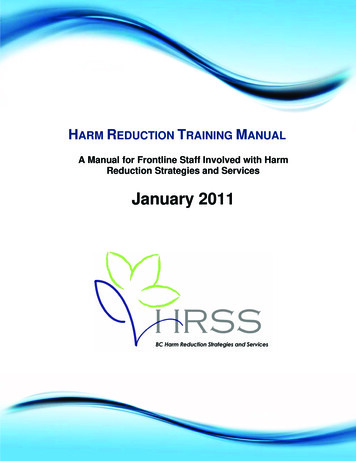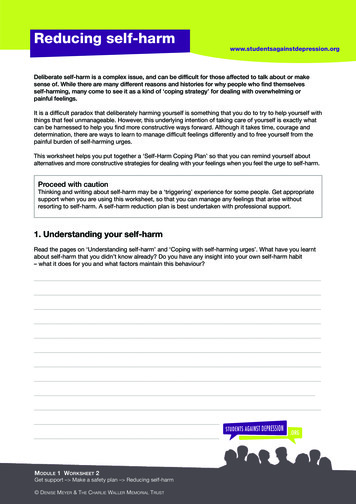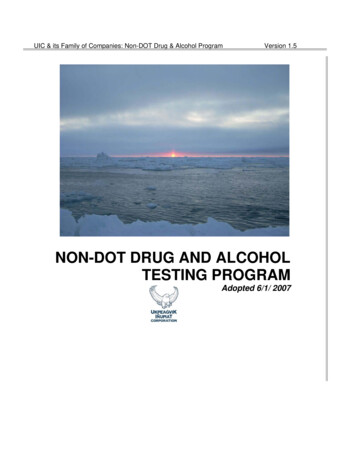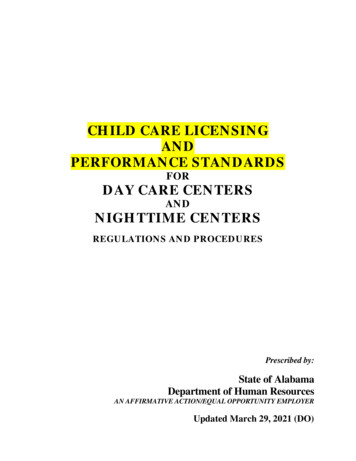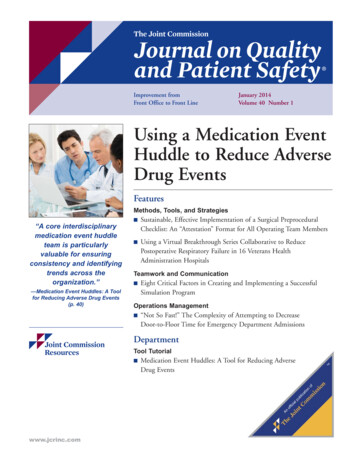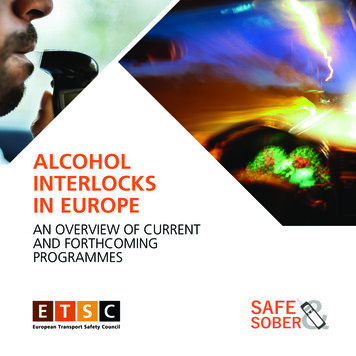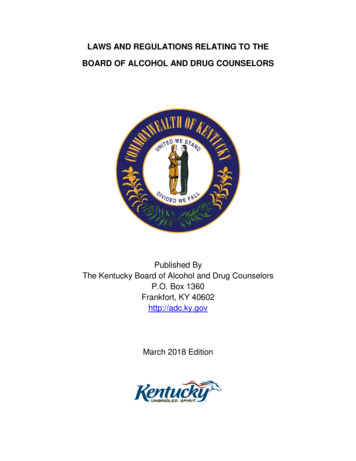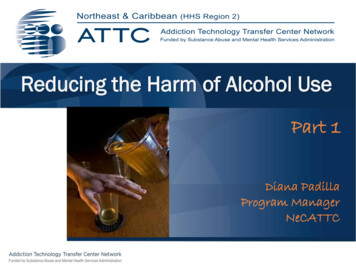
Transcription
Technical Support (800) 263-6317Reducing the Harm of Alcohol UsePart 1Diana PadillaProgram ManagerNeCATTC
Technical Support (800) 263-6317Diana Padilla is a program manager at NDRI-USA, Inc.,and a senior staff trainer for the Northeast & CaribbeanAddiction Transfer Technology Center Network (NeCATTC).Ms. Padilla has a 20 year history of public health servicewhich include direct service delivery predominantly tocommunities of color, disseminates research to practice incurricula development, conducts evaluation activities ofsubstance use treatment programs and problem solvingcourts, engages in chronic disease research and prevention,and instructs behavioral health professionals, preventionspecialists, and drug court practitioners on addiction andrecovery support best practices.This webinar training is provided under New York State Office of Alcoholism and Substance Abuse Services(OASAS) Education and Training Provider Certification Number 0115. Training under a New York State OASASProvider Certification is acceptable for meeting all or part of the CASAC/CPP/CPS education and trainingrequirements.2
Technical Support (800) 263-6317Important Information about CASAC, CPP, CPS Hours Everyone must attend both sessions - don’t leaveearly! Participants will receive a link for an evaluation afterthe 2nd session When we receive the evaluation, we will generate acertificate for 3 CASAC, CPP, CPS hours in 3-5business days We cannot give partial hours if you only complete onesession or partial sessions If some of you are sharing computers, please typeeveryone’s name in the Q & A (instructions on nextslide) & fills out an evaluation3
Technical Support (800) 263-6317Webinar Logistics:Control PanelRaise your handQ&ANow is when you should type in thenames of persons sharing a computer,later all need to fill the evaluation toreceive a certificate.4
Regional ATTCsTechnical Support (800) 263-63175
Technical Support (800) 263-6317International ATTCs6
ObjectivesTechnical Support (800) 263-6317Part I - August 17, 1-2:30p State prevalence of alcohol use in the US List health risks and consequences associated withalcohol misuse Define ‘reverse tolerance,’ and ‘tolerance reversal’ Define ‘low risk and at-risk drinking according to theNIAAA Define terms such as ‘alcohol proof’ and a ‘standarddrink’ Identify factors for special populations andconsiderations for counseling7
ObjectivesTechnical Support (800) 263-6317Part II - August 24, 1-2:30p List factors that make a person more/or less likely todrink to excess, to seek treatment for an alcoholproblem Identify evidence based screening tools List reasons for conducting culturally informedscreenings and assessments Evidence based interventions to address risky levels ofalcohol consumption Define harm reduction and list harm reduction strategies Case study practice8
Technical Support (800) 263-63179
Technical Support (800) 263-631710Alcohol Use in the United States According to NIAAA and CDC, nearly 88,000 people (approx62,000 men/26,000 women) die from alcohol-related causesannually. In 2015, 10,265 people died in alcohol-impaired drivingcrashes, accounting for nearly one-third (29%) of all trafficrelated deaths in the United States. An average of 1 alcohol-impaired-driving fatality occurredevery 50 minutes in 2016. Increases in drinking were greatest among women, olderadults, racial and ethnic minorities and people with loweducation and income levels.Department of Transportation (US), National Highway Traffic Safety Administration(NHTSA). Traffic Safety Facts 2014 data: alcohol-impaired driving. Washington, DC:NHTSA; 2015 [cited 2016 Feb 5]. Available at URL: http://wwwnrd.nhtsa.dot.gov/Pubs/812231.pdf, bit.ly/2uoeMc0 .JAMA Psychiatry, online August9, 2017, Prevalence of 12-Month Alcohol Use, High-Risk Drinking
Technical Support (800) 263-6317Continuum of Alcohol UsePotential eBingeUseAlcoholUseDisordermyths
About Alcohol Technical Support (800) 263-6317Alcohol is a great way to relax and reducestress.Fact: Alcohol increases the level of stress thatis placed on the body. Adrenaline levelsincrease in the body as we drink.12
About Alcohol Technical Support (800) 263-6317Alcohol is an aphrodisiac.Fact: Alcohol reduces inhibitions and maystimulate your interest in sex, but it reducesyour ability to perform and on sensitivity tostimuli.13
About Alcohol Technical Support (800) 263-6317Coating your stomach with a milky solution willslow the absorption of alcohol and keep aperson from getting drunk or sick.Fact: The stomach cannot be "coated" toprevent alcohol absorption.14
About Alcohol Technical Support (800) 263-6317Coffee, cold showers, and exercise will helpsober someone up.Fact: None of these methods will work. Theblood alcohol concentration only diminishesat a set, slow, pace as the liver metabolizesthe alcohol.15
Technical Support (800) 263-6317High Death Rates16
Technical Support (800) 263-6317Alcoholeffects onthe body17
Technical Support (800) 263-631718Consequences of Alcohol UseAlcohol use is a factor in many injuries, including: 40-50% of fatal motor vehicle crashes 60-70% of homicides 40% of suicides 60% of fatal burn injuries 70% of drownings 40% of fatal fallsIn 2010, excessive alcohol use cost the US economy 249billion. Binge drinking is responsible for over half the deathsand three-quarters of the costs due to excessive alcohol useNIAAA, Risky Drinking Can Put a Chill on Your Summer Safety/SummerSafety.htm,Preventing a Leading Risk for Death, Disease, and Injury, At A Glance publications/aag/alcohol.htm
Technical Support (800) 263-6317Bi Phasic ResponseWhat is a Cultural Myth?“If a few drinks make me feelgood, a lot of drinks willmake me feel even better.”2 different effects or phasesStimulated ”buzzed”Intoxication slurredspeech, decreased motorability, impaired thinking andjudgment.Lewis & Clark College, Tips to Reduce from Alcohol Use,www.lclark.edu/live/files/7828-reducing-risk19
Technical Support (800) 263-6317Bi-Phasic ResponseTolerance: as youdevelop tolerance,(curved yellow line) thepositive feelings arelessBalance: (.05 BAL orless) typically givepeople the experiencethey want from drinkingLewis & Clark College, Tips to Reduce from Alcohol Use,www.lclark.edu/live/files/7828-reducing-risk20
Technical Support (800) 263-631721What’s the Difference Between ?Reverse Tolerance vs Tolerance ReversalHeavy drinker withextensive liver damagebecomes intoxicated onsmall amounts ofalcoholHeavy drinker does aperiod of abstinencefrom alcohol and returnsto levels similar to whenthey began to drinkheavilyHarm Reduction for Alcohol, What is Reverse Tolerance?, http://hams.cc/reverse/Anchor Bay Recovery, Reverse Tolerance to ction/reverse-tolerance-to-alcohol
Technical Support (800) 263-631722
NIAAA Drink ScaleTechnical Support (800) 263-631723
Define a ‘drink’Technical Support (800) 263-6317In the United States, a standard drink contains 0.6ounces (14.0 grams) of pure alcohol. Generally, thisamount of pure alcohol is found in: 12-ounces of beer (5% alcohol content) 8-ounces of malt liquor (7% alcohol content) 5-ounces of wine (12% alcohol content) 1.5-ounces of 80-proof (40% alcohol content)distilled spirits or liquor (e.g., gin, rum, vodka,whiskey)CDC, Alcohol Use and Your hol-use.htm24
Bottle LabelsTechnical Support (800) 263-6317 Alcohol proof is a measureof how much ethanol(alcohol) is contained in analcoholic beverage Double the number listed asthe alcohol by volume onthe bottle. A spirit with 40percent alcohol by volume,therefore, is 80 proof.A bottle of 151 proof ("over-proof") rum25
Technical Support (800) 263-631726At-Risk Drinking Levels Moderate drinking:1 drink per day for womenand up to 2 drinks per day for men Binge drinking: (BAC) levels to 0.08 g/dL,typically after 4 drinks for women ( 65) and 5drinks for men, in about 2 hours. Heavy drinking: 5 or more drinks on thesame occasion on each of 5 or more days inthe past 30 days Low Risk for Alcohol Use Disorder (AUD):for women, low-risk drinking is no more than 3drinks on any single day and no more than 7drinks per weekNIAAA, Drinking Levels Defined, cohol-consumption/moderate-binge-drinking
Technical Support (800) 263-6317NIAAA Recommended LevelsExceeding these limits is a red flagindicating a need for a full isky/Whats-Low-Risk- 27Drinking.aspx
Technical Support (800) 263-6317Types of Drinkers, US5% Dependent20% Dependence symptomsHarmfulHazardous75% Low riskCurrent abstinenceLifetime abstinence28
Technical Support (800) 263-6317Social - Ecological FrameworkAlcohol Research Current Review, Influences of Social and Cultural Contexts of Alcohol Use29
Technical Support (800) 263-6317Binge Drinking & Diverse Communities American Indian/Alaska Natives (30.2%) Whites (23.9%) Hispanic/Latinos (23.2%) African Americans (20.6%) Asians (12.7%)Cultural norms and beliefs are strong predictorsof both current drinking and frequent heavydrinking and vary by context and place.ARCR, Alcohol Research Current icle04.htm30
Technical Support (800) 263-6317Other Special Populations Adolescents Most (81.4%) of the 4.3 million individuals who first began usingalcohol during the past year were younger than age 21. Approximately 58.3% wereyounger than age 18 Pregnant women (FASD) Drinking during pregnancy can cause brain damage,leading to a range of developmental, cognitive, and behavioral problems, which canappear at any time during childhood. Older adults Alcohol and prescription drug problems, among adults 60 and older isone of the fastest growing health problems facing the country Substance using persons Having alcohol in your blood can potentially cause yourbody to absorb the active ingredient tetrahydrocannabinol (THC) faster Mental Health Alcohol is a depressant, which means it can disrupt that balance, affecting ourthoughts, feelings and actions – and sometimes our long-term mental health. Persons with chronic infections (HIV, HepC, etc) Cultural groups31
Technical Support (800) 263-6317College DrinkingBinge drinking and the college environmentDeathAbout1825 college students (18-24yrs) die from alcoholrelated unintentional injuries including motor-vehiclecrashesAssault696,000 students (18-24yrs) are assaulted by anotherstudent who has been drinkingSexual assault97000 students (18-24yrs) report experiencing alcoholrelated sexual assault or date rapeARCR, Alcohol Research Current icle04.htm32
Technical Support (800) 263-631733Cultural Competence Core ElementsAwareness Differences of culture and one’s own Value diversityAttitude Aware of own biases, values & belief systems Acknowledgement & respect for cultural differencesKnowledge Inherent cultural trends of population Current research on effective practiceSkills Use of appropriate name or pronouns Engagement approachesAddiction Counseling Competencies, ounseling-Competencies/SMA15-4171
Technical Support (800) 263-6317 For those sharing a computer, have youtyped in your names in the Q & A box? Otherwise you will not receive the evaluationlink which you need to receive a certificateof completion. (Clyde, please launch the evaluation link)34
Technical Support (800) 263-6317Reducing the Harm of Alcohol UseEnd of Part OnePart Two:August 24, 1-2:30pPresenter:Diana Padilla, RCR, CASAC-TProgram Manager/Senior TrainerOrganizer:Clyde FrederickTechnologist/Program SupportA follow-up email will be sent to your in-box one hourafter part 2 on March 30, 2018. Please complete yourevaluation to receive your OASAS “Certificate ofCompletion”. It will only take a few minutes. This courseprovides 3 CASAC hours. Your certificate will be issued in3-5 business days.35
Addiction Transfer Technology Center Network (NeCATTC). Ms. Padilla has a 20 year history of public health service which include direct service delivery predominantly to communities of color, disseminates research to practice in curricula development, conducts evaluation activities of substance use treatment programs and problem solving


